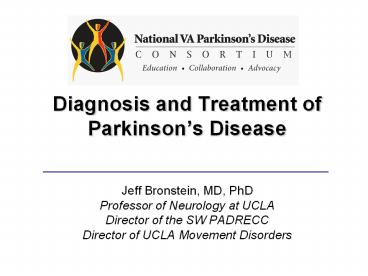Diagnosis and Treatment of Parkinson - PowerPoint PPT Presentation
Title:
Diagnosis and Treatment of Parkinson
Description:
95% likely caused by genetic predisposition and environmental influences ... R/O orthostatic hypotension. physical therapy for training and assistive devices. ... – PowerPoint PPT presentation
Number of Views:194
Avg rating:3.0/5.0
Title: Diagnosis and Treatment of Parkinson
1
Diagnosis and Treatment of Parkinsons Disease
- Jeff Bronstein, MD, PhD
- Professor of Neurology at UCLA
- Director of the SW PADRECC
- Director of UCLA Movement Disorders
2
Parkinsons Disease
- 2nd most common neurodegenerative disorder
- lifetime risk 1 in 40-100
- Age of onset
- Common after 60 y/o
- Young onset (20-50 y/o) 10-15
- Men get it more often than women
- 5 Inherited
- 95 likely caused by genetic predisposition and
environmental influences
3
Parkinsonism
- Tremor (rest)
- Rigidity
- Bradykinesia/akinesia
- Decreased facial expression
- Stooped posture
- Micrographia/hypophonia
- Postural instability
4
Not all Parkinsonians have Parkinsons Disease
Neurodegenerative Disorders
- Idiopathic Parkinsons Disease
- Multiple System Atrophy
- Progressive Supranuclear Palsy/CBGD
- Diffuse Lewy Body Disease
Secondary Parkinsonism
- Vascular
- Neuroleptics
- Normal Pressure Hydrocephalus
5
Differential Diagnosis
Parkinsonism Plus
- Multiple System Atrophy postural
instability - Shy-Drager dysautonomia
- Striatal nigral degeneration non
dopa-responsive - OPCA cerebellar dysfunction
- Progressive Supranuclear Palsy gaze
paresis - Diffuse Lewy Body Disease dementia
- Corticobasal Degeneration
dystonia, apraxia
Most do not respond to L-dopa and have early loss
of postural reflexes
6
MRI and MSA
7
18F-Dopa PET
Pavese and Brooks, 2008
8
Think Parkinsons Disease
With
- Asymmetric onset
- L-dopa responsive
- Rest tremor
- Cerebellar signs
- Long-tract signs
- Early dementia
- Early dysautonomia
- Early falls
Without
9
Initiation of Treatment
- General Considerations
- Age
- Young onset
- neuroprotection
- motor fluctuations
- Older patients
- cognitive issues
- comorbidities
- Disability
- Cost
10
Early Parkinsons Disease Treatment Guidelines
Parkinsons Disease
Pharmacologic therapy/ functional impairment
Nonpharmacologic therapy
No treatment has been shown to be neuroprotective2
Education
MAO-B Inhibitors (SEL) very mild symptomatic
benefit1
Support Services
Exercise2
Levodopa
Dopamine Agonists1
Nutrition
Combined treatment (/- COMT inhibitor)
AAN guidelines last updated in 2006 (2)
11
MAO-B Inhibition Selegiline and Rasagiline
- Both have small symptomatic effect.
- Both might slow disease down a little.
- Rasagiline and SL selegiline have been shown to
help wearing off (PO selegiline not well studied).
12
Rasagiline The TEMPO Trial
Siderowf, A. et al. Neurology 200666S80-S88
13
Levodopa
- Efficacy
- Most efficacious medication for control of PD
symptoms. - Improves UPDRS motor scores by approx 50 in
advanced patients. - Short half-life
- Significant protein effect
- Side-effects
- Long-term risk of motor fluctuations
14
Clinically, Levodopa Slows Ds Progression
15
Protein Effect
16
Dopamine Agonists
- Efficacy
- Less efficacious than levodopa
- Have long half-lives
- Less likely to cause motor fluctuations
- Absorption without transporter (no protein
effect) - Potential alternate routes of administration
(e.g. patch, injection) - Side-effects
- Relatively more common than for levodopa
especially in the elderly - Include sedation, hallucinations, impulse
control, nausea
17
CALM-PD Pramipexole vs Levodopa
45
Total UPDRS Score
40
35
Pramipexole
30
25
Mean Score
20
Levodopa
15
P lt .002 for each 3 month interval.
10
5
0
52
65
102
13
26
39
78
91
Weeks From Randomization
18
5 Yr Ropinirole vs. Levodopa
Rascol 2000
19
Initiating Therapy
Disabled
Yes
No
-MAO-B I -agonist (young) -Sinemet CR
-educate -exercise -MAO-B I?
-reg sinemet -question Dx -COMT-I -antichloinergic
inadequate response
20
Advancing Parkinsons Disease
- Motor fluctuations (young)
- Wearing off
- Dyskinesias
- On-off phenomenon
- Non-Motor Problems
- Medication-induced psychosis
- Cognitive decline
- Postural instability
- Urinary problems
- Sleep problems
21
Principles of Managing Fluctuations
- Decrease fluctuations of L-dopa blood levels
- Use smaller more frequent dosing.
- Use combination of regular and CR Sinemet.
- Add COMT inhibitor
- Add MAO-B inhibitor
- Add DA agonist and reduce L-dopa
- Add amantadine for dyskinesias
- Surgery
22
Levodopa Biochemistry
MAO
dopamine
dopamine
COMT
carbidopa
L-dopa
L-dopa
tolcapone
Entacapone/ tolcapone
?
3-OMD
3-OMD
BBB
23
Effect of COMT-I on Plasma Levels
L-DOPA
with COMT-I
without COMT-I
time
Sinemet
24
Advancing Parkinsons Ds
- Hallucinations
- D/C selegiline, anticholinergics, amantadine
- lower dopaminergic medications (agonist 1st)
- clozapine, quetiapine, cholinesterase-I
- Falls
- optimize therapy
- R/O orthostatic hypotension
- physical therapy for training and assistive
devices.
25
Advancing Parkinsons Ds (cont.)
- Depression
- serotonin uptake inhibitor (e.g.Paxil, Celexa),
nortriptyline, NA/Serotinergic uptake inhibitors,
Wellbutrin - Dementia
- R/o other causes (metabolic, structural etc.)
- Reduce medications as much as possible
- Consider cholinesterase-I, memenatine
26
Advancing Parkinsons Ds (cont.)
- Sleep Problems
- sleep hygiene
- optimize DA therapy
- treat depression
- Consider sleep study (apnea, RSB)
- Sleep initiation short acting benzo (Ambien,
Sonata), Rozerem. - Sleep maintenance Lunesta, Ambien CR, tricyclic
antidepressant (nortriptyline, trazadone),
Remeron, Benadryl
27
Summary
- Motor fluctuations are treatable but can require
time and persistence - Identify and treat non-motor problems, they can
be very disabling - When in doubt, call or refer to the National VA
Parkinsons Disease Consortium
http//www.vapdconsortium.org
28
Consortium Center Network
Red Star PADRECC Blue Star Consortium
Center Cyan Star-SW PADRECC































